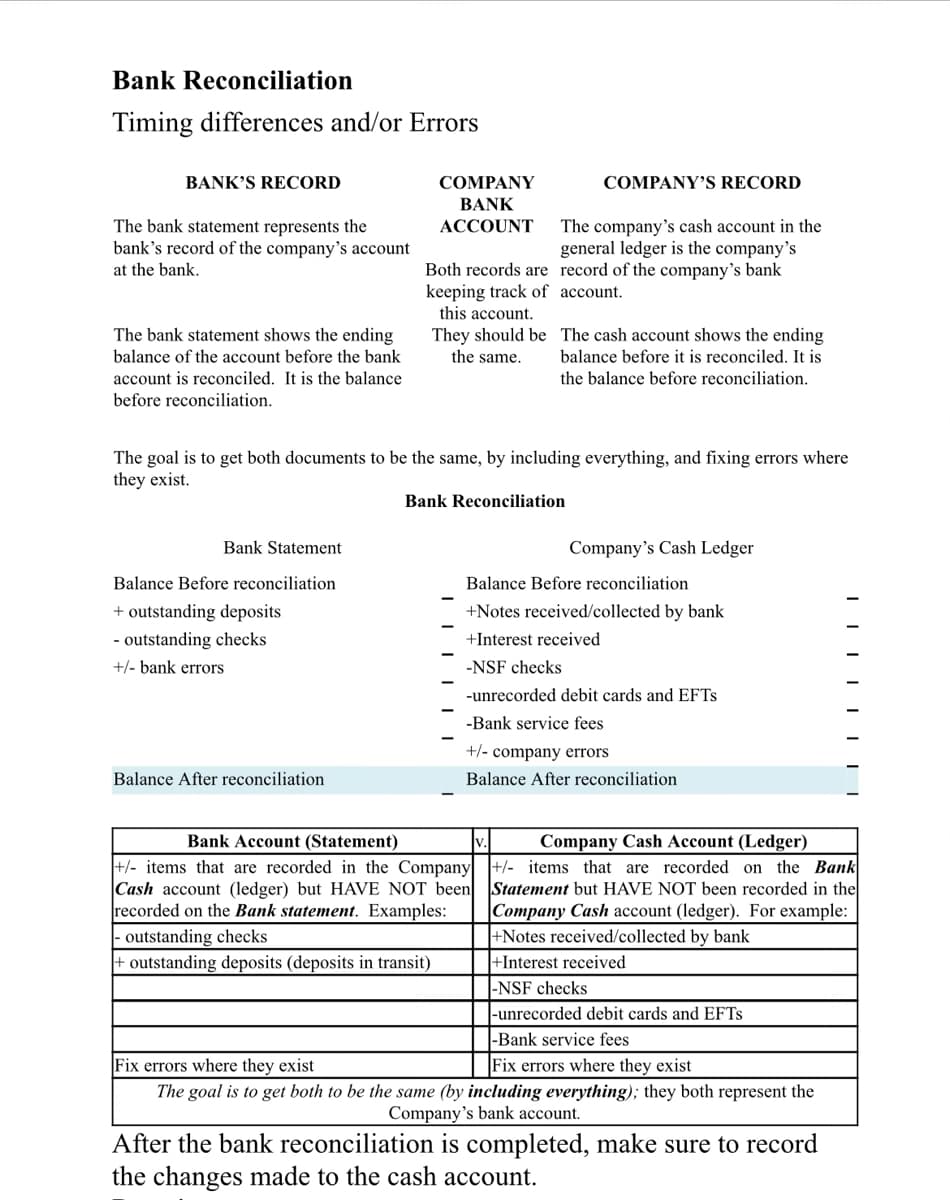From page 4-4 of the VLN, in a bank reconciliation how are outstanding deposits treated? A. Add to the company cash ledger balance B. Subtract from the company cash ledger balance C. Add to the bank statement balance D. Subtract from the bank statement balance
From page 4-4 of the VLN, in a bank reconciliation how are outstanding deposits treated? A. Add to the company cash ledger balance B. Subtract from the company cash ledger balance C. Add to the bank statement balance D. Subtract from the bank statement balance
Financial Accounting: The Impact on Decision Makers
10th Edition
ISBN:9781305654174
Author:Gary A. Porter, Curtis L. Norton
Publisher:Gary A. Porter, Curtis L. Norton
Chapter6: Cash And Internal Control
Section: Chapter Questions
Problem 6.1P
Related questions
Question
100%
From page 4-4 of the VLN, in a bank
reconciliation how are outstanding
deposits treated?
A. Add to the company cash ledger balance
B. Subtract from the company cash ledger
balance
C. Add to the bank statement balance
D. Subtract from the bank statement balance

Transcribed Image Text:Bank Reconciliation
Timing differences and/or Errors
BANK'S RECORD
СOMPANY
COMPANY'S RECORD
BANK
The bank statement represents the
bank's record of the company's account
at the bank.
The company's cash account in the
general ledger is the company's
АСCOUNT
Both records are record of the company's bank
keeping track of account.
this account.
The bank statement shows the ending
They should be The cash account shows the ending
the same.
balance of the account before the bank
balance before it is reconciled. It is
account is reconciled. It is the balance
the balance before reconciliation.
before reconciliation.
The goal is to get both documents to be the same, by including everything, and fixing errors where
they exist.
Bank Reconciliation
Bank Statement
Company's Cash Ledger
Balance Before reconciliation
Balance Before reconciliation
+ outstanding deposits
- outstanding checks
+Notes received/collected by bank
+Interest received
+/- bank errors
-NSF checks
-unrecorded debit cards and EFTS
-Bank service fees
+/- company errors
Balance After reconciliation
Balance After reconciliation
Bank Account (Statement)
Company Cash Account (Ledger)
|+/- items that are recorded in the Company +/- items that are recorded on the Bank
|Cash account (ledger) but HAVE NOT been Statement but HAVE NOT been recorded in the
recorded on the Bank statement. Examples:
|- outstanding checks
+ outstanding deposits (deposits in transit)
Company Cash account (ledger). For example:
|+Notes received/collected by bank
+Interest received
|-NSF checks
|-unrecorded debit cards and EFTS
|-Bank service fees
Fix errors where they exist
Fix errors where they exist
The goal is to get both to be the same (by including everything); they both represent the
Company's bank account.
After the bank reconciliation is completed, make sure to record
the changes made to the cash account.
Expert Solution
Step 1
Outstanding deposits is an item that has been recorded in the company’s cash book but has not br recotded in bank .
Trending now
This is a popular solution!
Step by step
Solved in 2 steps

Knowledge Booster
Learn more about
Need a deep-dive on the concept behind this application? Look no further. Learn more about this topic, accounting and related others by exploring similar questions and additional content below.Recommended textbooks for you

Financial Accounting: The Impact on Decision Make…
Accounting
ISBN:
9781305654174
Author:
Gary A. Porter, Curtis L. Norton
Publisher:
Cengage Learning


Century 21 Accounting Multicolumn Journal
Accounting
ISBN:
9781337679503
Author:
Gilbertson
Publisher:
Cengage

Financial Accounting: The Impact on Decision Make…
Accounting
ISBN:
9781305654174
Author:
Gary A. Porter, Curtis L. Norton
Publisher:
Cengage Learning


Century 21 Accounting Multicolumn Journal
Accounting
ISBN:
9781337679503
Author:
Gilbertson
Publisher:
Cengage

College Accounting (Book Only): A Career Approach
Accounting
ISBN:
9781337280570
Author:
Scott, Cathy J.
Publisher:
South-Western College Pub

College Accounting, Chapters 1-27
Accounting
ISBN:
9781337794756
Author:
HEINTZ, James A.
Publisher:
Cengage Learning,

Auditing: A Risk Based-Approach to Conducting a Q…
Accounting
ISBN:
9781305080577
Author:
Karla M Johnstone, Audrey A. Gramling, Larry E. Rittenberg
Publisher:
South-Western College Pub